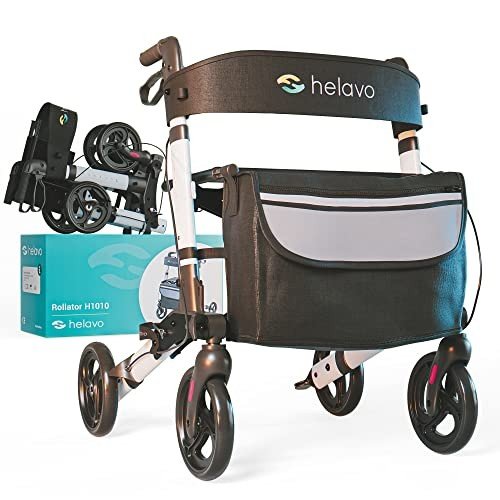20 Trailblazers Leading The Way In Rollator Walker
Rollator Walker Safety: A Comprehensive Guide
As people age or face mobility difficulties due to illness or injury, maintaining self-reliance typically becomes a top priority. Rollator walkers, supplying both assistance and mobility, have actually become important tools for many. However, while they use numerous benefits, guaranteeing safety while using a rollator walker is vital. This short article supplies extensive insights into Rollator Walker Safety – Www.eksklusifproperty2.rumahlembang.com,, including best practices, common risks, and necessary ideas for users and caretakers.
Understanding Rollators
A rollator walker is a mobility device with wheels that permits individuals to stroll with the assistance of a frame. Unlike standard walkers, rollators usually feature:
- Three or four wheels for easier maneuverability
- Hand brakes for stopping and controlling speed
- A seat for resting when required
- Storage compartments for bring personal items
These functions make rollators suitable for both indoor and outdoor use, improving the lifestyle for users by supplying a sense of independence.
Benefits of Using Rollator Walkers
- Increased Mobility: Rollators can help users in moving around safely and easily.
- Support and Stability: With a sturdy frame and brakes, they provide necessary assistance when standing or walking.
- Comfort: Many rollators come with padded seats, enabling users to rest as required.
- Convenience: Integrated storage solutions can bring vital items, releasing hands for better balance.
Typical Hazards Associated with Rollator Walkers
While rollators can enhance mobility and safety, they can also posture risks. Users must be conscious of prospective dangers to minimize mishaps:

- Uneven Surfaces: Rollators may tip over if used on unequal or sloped surface.
- Braking Issues: Failing to engage the brakes properly can lead to falls.
- Excess Weight: Overloading the storage compartments can impact stability.
- Inappropriate Use: Not utilizing the rollator as planned can result in accidents.
- Poor Maintenance: Neglecting routine checks on wheels and brakes could result in failure during use.
Rollator Walker Safety Tips
To enhance safety while using rollator walkers, consider the following pointers:
1. Appropriate Fit and Adjustment
- Height Adjustment: Ensure that the manage height is set to the user’s wrist level when standing upright. A correct fit encourages better posture and control.
- Seat Height: If the rollator has a seat, ensure it’s comfortable and accessible for resting.
2. Routine Maintenance
- Check Brakes: Make sure hand brakes are working effectively. Adjust or replace them if required.
- Check Wheels: Regularly inspect wheels for wear and tear, and guarantee they spin freely.
- Take a look at Frame: Check for loose screws or cracks in the frame to ensure it stays sturdy.
| Maintenance Task | Frequency |
|---|---|
| Brake check | Weekly |
| Wheel inspection | Regular monthly |
| Frame assessment | Monthly |
3. Environment Awareness
- Clear Pathways: Keep living spaces complimentary from mess and challenges that might present a tripping risk.
- Lighting: Ensure that areas are well-lit to prevent missteps, especially during evening hours.
- Prevent Slippery Floors: Be careful on wet or waxed floors, as they can lead to falls.
4. Safe Walking Techniques
- Engage Brakes When Stopping: Always engage brakes before sitting or while resting.
- Use Proper Walking Technique: Move gradually and maintain a stable rate, taking steps that match the rollator’s width.
- Balance While Turning: Turn thoroughly, using the rollator for support as needed.
5. Look for Assistance
- Involve Caregivers: Encourage relative or caretakers to help in browsing tough surfaces or scenarios.
- Make The Most Of Community Resources: Many communities offer mobility training for those utilizing walk-assisting gadgets.
FAQs about Rollator Walker Safety
Q1: How do I choose the best rollator walker?
When picking a rollator, think about the user’s weight, height, and meant use. It’s also important to examine for functions such as hand brake efficiency and wheel size, which can affect maneuverability.
Q2: Can I use a rollator walker on irregular surfaces?
While rollators can deal with a variety of terrains, it is best to prevent high inclines, gravel, or cobblestones, as these can be dangerous. Adhere to flat, smooth surface areas whenever possible.
Q3: How can I prevent falls while using a rollator?
Engaging the brakes when sitting, keeping paths clear, changing your rollator for the correct height, and being conscious of your environments can greatly minimize the risk of falls.
Q4: Are all rollator walkers the exact same?
No, rollators are available in various types and sizes, developed for various needs. Some might have extra devices like baskets, while others are lightweight or feature a greater weight capacity.

Q5: Is it safe to bring bags on a rollator?
Always bear in mind the weight limitation and circulation of the load. Use the rollator’s designated storage services and prevent overloading it.
Rollator walkers are important gadgets that enhance mobility and promote independence for users facing mobility obstacles. However, ensuring safety while using these devices is crucial. By comprehending possible dangers, sticking to safe practices, and keeping the walker frequently, users can enjoy the benefits of their rollator with decreased threat. Ultimately, the goal is to facilitate self-confidence and stability, making it possible for individuals to navigate their world with security and ease. As care companies, relative, and neighborhoods focus on safety, they empower users towards a much better, more independent lifestyle.


